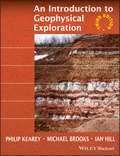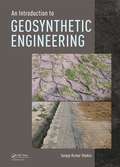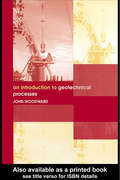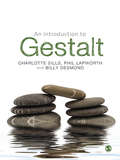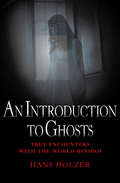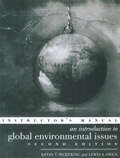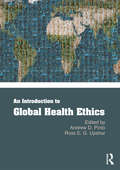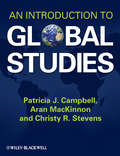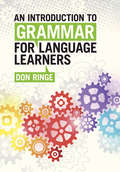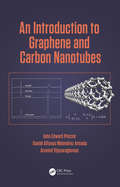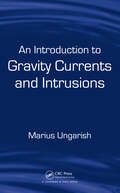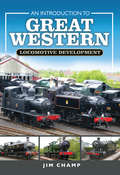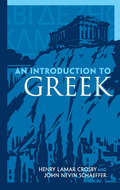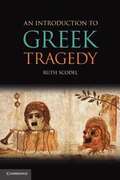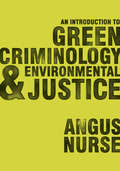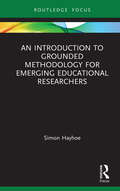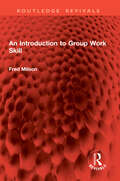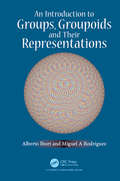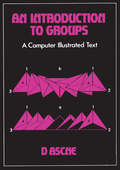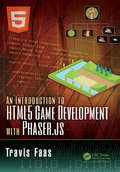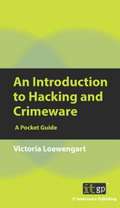- Table View
- List View
An Introduction to Geophysical Exploration
by Michael Brooks Philip Kearey Ian HillThis new edition of the well-established Kearey and Brooks text is fully updated to reflect the important developments in geophysical methods since the production of the previous edition. The broad scope of previous editions is maintained, with even greater clarity of explanations from the revised text and extensively revised figures. Each of the major geophysical methods is treated systematically developing the theory behind the method and detailing the instrumentation, field data acquisition techniques, data processing and interpretation methods. The practical application of each method to such diverse exploration applications as petroleum, groundwater, engineering, environmental and forensic is shown by case histories. The mathematics required in order to understand the text is purposely kept to a minimum, so the book is suitable for courses taken in geophysics by all undergraduate students. It will also be of use to postgraduate students who might wish to include geophysics in their studies and to all professional geologists who wish to discover the breadth of the subject in connection with their own work.
An Introduction to Geosynthetic Engineering
by Sanjay Kumar ShuklaThe development of the use of polymeric materials in the form of geosynthetics has brought about major changes in the civil engineering industry. Geosynthetics are available in a wide range of compositions appropriate to different applications and environments. Over the past three to four decades, civil engineers have grown increasingly interested
An Introduction to Geosynthetic Engineering
by Sanjay Kumar ShuklaGeosynthetics, primarily made from synthetic polymers, provide efficient, cost-effective, and sustainable solutions for civil, geotechnical, and environmental challenges. Enhancing infrastructure performance with soil and rock, they are integral to global construction standards. Beyond civil engineering, their applications extend to mining, agriculture, and aquaculture. This book explores the principles, properties, and applications of geosynthetics, offering tailored solutions for innovative and sustainable infrastructure development.This updated second edition of An Introduction to Geosynthetic Engineering provides a comprehensive introduction to geosynthetics, meeting the needs of senior undergraduate and postgraduate students, practising engineers, and professionals. It includes expanded content, updated chapters, new sections, detailed site photographs, revised standards and guidelines, additional examples, and practice questions. Tailored to support both learning and practical application, this textbook is an essential resource for understanding and utilizing geosynthetics in sustainable infrastructure development.
An Introduction to Geotechnical Processes
by John WoodwardThe study of the solid part of the earth on which structures are built is an essential part of the training of a civil engineer. Geotechnical processes such as drilling, pumping and injection techniques enhance the viability of many construction processes by improving ground conditions.Highlighting the ground investigation necessary for the process
An Introduction to German Pietism: Protestant Renewal at the Dawn of Modern Europe (Young Center Books in Anabaptist and Pietist Studies)
by Douglas H. ShantzAn up-to-date portrait of a defining moment in the Christian story—its beginnings, worldview, and cultural significance.Winner of the Dale W. Brown Book Award of the Young Center for Anabaptists and Pietist Studies at Elizabethtown CollegeAn Introduction to German Pietism provides a scholarly investigation of a movement that changed the history of Protestantism. The Pietists can be credited with inspiring both Evangelicalism and modern individualism.Taking into account new discoveries in the field, Douglas H. Shantz focuses on features of Pietism that made it religiously and culturally significant. He discusses the social and religious roots of Pietism in earlier German Radicalism and situates Pietist beginnings in three cities: Frankfurt, Leipzig, and Halle. Shantz also examines the cultural worlds of the Pietists, including Pietism and gender, Pietists as readers and translators of the Bible, and Pietists as missionaries to the far reaches of the world. He not only considers Pietism's role in shaping modern western religion and culture but also reflects on the relevance of the Pietist religious paradigm of today.The first survey of German Pietism in English in forty years, An Introduction to German Pietism provides a narrative interpretation of the movement as a whole. The book's accessible tone and concise portrayal of an extensive and complex subject make it ideal for courses on early modern Christianity and German history. The book includes appendices with translations of German primary sources and discussion questions.
An Introduction to Gestalt
by Charlotte Sills Mr Phil Lapworth Billy DesmondThis thoroughly revised edition of Gestalt Counselling introduces the fundamental concepts of Gestalt and systematically demonstrates how to apply and use these in practice. Taking a relational perspective, the expert authors explore how Gestalt can be used in a wide variety of 'helping conversations' from counselling, psychotherapy and coaching to mentoring, managing, consulting and guiding. A Each chapter contains case examples from the therapeutic world and a 'running case study' featuring ongoing coaching work moves throughout the book, with diagrams and lists for further reading making this the ideal text for use in training. The accessible, engaging writing style will appeal to undergraduates and postgraduates alike. Charlotte Sills is a practitioner and supervisor in private practice, a tutor at Metanoia Institute and a tutor and supervisor of coaching at Ashridge CollegeBusiness School. She is the author or co-author of many books and articles on therapeutic work. Phil Lapworth is a counsellor, psychotherapist and supervisor in private practice near Bath and has written extensively in the field of counselling and psychotherapy. Billy Desmond is a Gestalt psychotherapist, executive coach and organisational development consultant. He is a member of Ashridge College and a Programme Director of Partnering and Consulting in ChangeHead of the Gestalt Department at Metanoia Insititute, and tutor and consultant at Ashridge Business School.
An Introduction to Ghosts: True Encounters With The World Beyond (True Encounters with the World Beyond #7)
by Hans HolzerJoin paranormal expert and storyteller extraordinaire Hans Holzer as he explores ghostly manifestations of every variety and delves into the true nature of the &“other side&”In this groundbreaking work, professor Hans Holzer provides a thorough introduction to the art and science of successful and lucid communication with the world beyond. Here he delves into the nature of life and death, shares invaluable information that every would-be ghost hunter should know, and explains the exact nature of what we understand to be a &“ghost.&”
An Introduction to Global Environmental Issues Instructors Manual
by Lewis A. Owen Professor Kevin PickeringAn Introduction to Global Environmental Issues presents a comprehensive stimulating introduction to the key environmental issues presently threatening our global environment. Offering an authoritative introduction to the key topics, a source of latest environmental information, and an innovative stimulus for debate, this is an essential book for all those studying or concerned with global environmental issues.In this second edition, the most topical global environmental issues are brought more clearly into focus. Explanations of the evolution of the earth's natural systems (hydrosphere, biosphere, geosphere, ecosphere) provide the essential understanding of the scientific concepts, processes and historical background behind key environmental issues. Contemporary socio-economic, cultural and political considerations are explored and important conceptual approaches such as Gaian hypotheses and Chaos Theory are introduced. Human impact and management of the natural environment, and concerns for maintaining biodiversity are emphasised throughout.Specific features include: Case studies drawn from across the world Superb illustrations: 4-colour plate sections; a wealth of informative diagrams Glossary of key terms, with key concepts highlighted throughout the text Annotated guides to Further Reading Chapter summaries and key points A new Instructors' Manual is available to accompany the text
An Introduction to Global Health Ethics
by Andrew D. Pinto Ross E. UpshurThe field of global health is expanding rapidly. An increasing number of trainees are studying and working with marginalized populations, often within low and middle-income countries. Such endeavours are beset by ethical dilemmas: mitigating power differentials, addressing cultural differences in how health and illness are viewed, and obtaining individual and community consent in research. This introductory textbook supports students to understand and work through key areas of concern, assisting them in moving towards a more critical view of global health practise. Divided into two sections covering the theory and practice of global health ethics, the text begins by looking at definitions of global health and the field’s historical context. It draws on anti-colonial perspectives concepts, developing social justice and solidarity as key principles to guide students. The second part focuses on ethical challenges students may face in clinical experiences or research. Topics such as working with indigenous communities, the politics of global health governance, and the ethical challenges of advocacy are explored using a case study approach. An Introduction to Global Health Ethics includes recommended resources and further readings, and is ideal for students from a range of disciplines – including public health, medicine, nursing, law and development studies – who are undertaking undergraduate and graduate courses in ethics or placements overseas.
An Introduction to Global Media for the Twenty-First Century
by Ole J. MjøsAn Introduction to Global Media for the Twenty-First Century provides a thorough introduction to the field of global media today. The book presents the key changes taking place as the global media landscape evolves, and the main theories of the field, that explain these developments. <p><p> Tracing, first, the formative development of an international and global media landscape throughout the 20th century from the telegraph, television and film export, and transnational television to the Internet, the book then focuses on developments in the 21st century. This includes: the digitization of the global media and communications sector; the popularization of the Internet and digital infrastructure such as the smartphone and platforms; the emergence of global online media and services; the production and distribution of digital media content; and the exploitation of user data. Case studies illustrate key developments throughout the book. <p><p> The book shows how the field is characterized by a continuity of critical concerns in relation to power, influence, and domination; media user empowerment and exploitation; and social and sustainable development and democratic conditions, as well as geopolitical shifts, in a global context.
An Introduction to Global Studies
by Aran Mackinnon Christy R. Stevens Patricia J. CampbellTaking an interdisciplinary approach, An Introduction to Global Studies presents readers with a solid introduction to the complex, interconnected forces and issues confronting today's globalized world.Introduces readers to major theories, key terms, concepts, and notable theoristsEquips readers with the basic knowledge and conceptual tools necessary for thinking critically about the complex issues facing the global communityIncludes a variety of supplemental features to facilitate learning and enhance readers' understanding of the material
An Introduction to Grammar for Language Learners
by Don RingeLearning a foreign language is much easier when it is approached with a knowledge of language structure ('grammar'), but many students find grammar mystifying. This text explains points of grammar straightforwardly using examples from several widely-studied languages, including English, so that students can see how the same principles work across different languages, and how the structures of different languages correspond both formally and functionally. The use of concrete examples makes grammar less abstract and easier to grasp, allowing students to relate what they are learning to knowledge that they already possess unconsciously; it simultaneously brings that knowledge up to a conscious level.
An Introduction to Graphene and Carbon Nanotubes
by John E. Proctor Daniel Melendrez Armada Aravind Vijayaraghavan<p>Carbon nanotubes and graphene have been the subject of intense scientific research since their relatively recent discoveries. This book introduces the reader to the science behind these rapidly developing fields, and covers both the fundamentals and latest advances. Uniquely, this book covers the topics in a pedagogical manner suitable for undergraduate students. The book also uses the simple systems of nanotubes and graphene as models to teach concepts such as molecular orbital theory, tight binding theory and the Laue treatment of diffraction. <p>Suitable for undergraduate students with a working knowledge of basic quantum mechanics, and for postgraduate researchers commencing their studies into the field, this book will equip the reader to critically evaluate the physical properties and potential for applications of graphene and carbon nanotubes.</p>
An Introduction to Gravity Currents and Intrusions
by Marius UngarishGravity currents and intrusions are the ubiquitous phenomena where a fluid of one density flows horizontally into a fluid of a different density. For researchers and engineers, the ability to understand and predict these flow fields is essential in wide-ranging applications including those involved with atmospheric and ocean dynamics, the propagati
An Introduction to Great Western Locomotive Development
by Jim ChampThe first thought, when contemplating a new study of the Great Western Railway locomotive fleet, must surely be to ask what can there be left to say? But there is no single source which gives a general introduction to the Great Western locomotive fleet. There are monographs on individual classes, an excellent multi-volume detail study from the RCTS, and superb collections of photographs, but nothing that brings it all together. This work is intended to provide that general introduction.The volume begins with a series of short essays covering general trends in design development, whilst the main body of the volume covers individual classes. For each class there is a small table containing some principal dimensions and paragraphs of text, covering an introduction, renumbering, key changes in the development of the class and information on withdrawal.The volume concludes with appendices covering the development and types of standard boilers, the various numbering schemes used by the GWR, the arcane subject of locomotive diagrams and lot numbers, and a short reference on the many lines the GWR engulfed.The majority of illustrations are new profile drawings to a consistent format. Described as sketches, they are drawn to a consistent scale, but do not claim to be scale drawings. Much minor equipment has been omitted and the author has certainly not dared to include rivets! Although most are based around GWR weight diagrams, they are not simple traces of the original drawings. Detail has been added from other sources, components copied from different drawings and details have been checked against historical and modern photographs. One must also bear in mind that steam locomotives were not mass produced. Minor fittings frequently varied in position and changes were made over the locomotives' lifetimes. Nevertheless, this collection of drawings provides a uniquely consistent view of the GWR locomotive fleet.
An Introduction to Greek
by Henry Lamar Crosby John Nevin SchaefferGenerations of students have discovered the enduring pleasures of ancient Greek with this classic text. Supplemented by exercises, readings, and review lessons, it presents concise but thorough coverage of grammatical forms and syntax. Students advance from the simple fundamentals of the alphabet and declensions to the complexities of conditional sentences, and they acquire a Greek vocabulary of more than 600 basic words.Each chapter begins with a Greek motto, offering insights into classical attitudes and values. Reading selections include the works of Plato, Herodotus, and Homer as well as excerpts from ancient playwrights and the New Testament. More than 120 illustrations depict images of Greek culture related to archaeology, history, and literature. This comprehensive introduction also features Greek-to-English and English-to-Greek glossaries, a complete grammatical appendix, and supplemental information on word formation and etymology.
An Introduction to Greek Tragedy
by Ruth ScodelThis book provides a brief and accessible introduction to Greek tragedy for students and general readers alike. Whether readers are studying Greek culture, performing a Greek tragedy, or simply interested in reading a Greek play, this book will help them to understand and enjoy this challenging and rewarding genre. An Introduction to Greek Tragedy provides background information; helps readers appreciate, enjoy, and engage with the plays themselves; and gives them an idea of the important questions in current scholarship on tragedy. Ruth Scodel seeks to dispel misleading assumptions about tragedy, stressing how open the plays are to different interpretations and reactions. In addition to general background, the book also includes chapters on specific plays, both the most familiar titles and some lesser-known plays - Persians, Helen, and Orestes - in order to convey the variety that the tragedies offer readers.
An Introduction to Green Criminology and Environmental Justice
by Dr Angus NurseA comprehensive introduction to green criminology, this book is a discussion of the relationship between mainstream criminal justice and green crimes. Focused on environmental harm within the context of criminal justice this book takes a global perspective and Introduces students to different theoretical perspectives in green criminology Looks at the victims of environmental crime throughout Covers topics such as; wildlife crimes, animal abuse, the causes of environmental crime, regulation, exploitation, environmental activism, policing, prosecution and monitoring. Designed to help readers develop a thorough understanding of the principles of environmental justice and green criminology, as well as contemporary developments, this book will be excellent support to students of green criminology and environmental crime.
An Introduction to Green Criminology and Environmental Justice
by Dr Angus NurseA comprehensive introduction to green criminology, this book is a discussion of the relationship between mainstream criminal justice and green crimes. Focused on environmental harm within the context of criminal justice this book takes a global perspective and Introduces students to different theoretical perspectives in green criminology Looks at the victims of environmental crime throughout Covers topics such as; wildlife crimes, animal abuse, the causes of environmental crime, regulation, exploitation, environmental activism, policing, prosecution and monitoring. Designed to help readers develop a thorough understanding of the principles of environmental justice and green criminology, as well as contemporary developments, this book will be excellent support to students of green criminology and environmental crime.
An Introduction to Grounded Methodology for Emerging Educational Researchers (Qualitative and Visual Methodologies in Educational Research)
by Simon HayhoeIntroducing the reader to grounded methodology and its ethical approach, this book explores the theory behind the method as well as how to use it to develop and evaluate learning and education projects. Grounded methodology is designed to challenge traditional educational research methodologies, and in doing so questions the notion of the need for highly formal research in institutional settings. In this respect, it is also a simple way of planning an educational project that needs an evaluative element. Covering data collection techniques used in the course of education research such as observations, interviews, course development, participant diaries and online data collection, this book investigates the practical realities of researching in education contexts and the differences in educational, national and cultural backgrounds. It is ideal reading for students and academics looking to update and increase their knowledge on grounded methodology, especially students who are researchers in final-year undergraduate or post-graduate level programs, or instructors planning to teach grounded theory or grounded methodology to their own emerging research students.
An Introduction to Group Work Skill (Routledge Revivals)
by Fred MilsonFirst Published in 1973, An Introduction to Group Work Skill is designed to make the understanding of group work skills accessible to all- mothers, teachers, employers, as well as professional social workers. Dr Milson argues that this lengthy and imaginative excursion has been thought necessary as we are here concerned with the behaviour of people in groups which meet fairly regularly, which are small enough to provide opportunities for every member to know every other member as a person, and where there is a goal to be achieved which calls for a contribution from each.The author further argues that group work skill is composed of observation, interpretation, and action, and he proceeds to analyze each of these elements in successive chapters. This is an interesting read for students of sociology of work and social work.
An Introduction to Groups, Groupoids and Their Representations: An Introduction
by Alberto Ibort Miguel A. RodriguezThis book offers an introduction to the theory of groupoids and their representations encompassing the standard theory of groups. Using a categorical language, developed from simple examples, the theory of finite groupoids is shown to knit neatly with that of groups and their structure as well as that of their representations is described. The book comprises numerous examples and applications, including well-known games and puzzles, databases and physics applications. Key concepts have been presented using only basic notions so that it can be used both by students and researchers interested in the subject. Category theory is the natural language that is being used to develop the theory of groupoids. However, categorical presentations of mathematical subjects tend to become highly abstract very fast and out of reach of many potential users. To avoid this, foundations of the theory, starting with simple examples, have been developed and used to study the structure of finite groups and groupoids. The appropriate language and notions from category theory have been developed for students of mathematics and theoretical physics. The book presents the theory on the same level as the ordinary and elementary theories of finite groups and their representations, and provides a unified picture of the same. The structure of the algebra of finite groupoids is analysed, along with the classical theory of characters of their representations. Unnecessary complications in the formal presentation of the subject are avoided. The book offers an introduction to the language of category theory in the concrete setting of finite sets. It also shows how this perspective provides a common ground for various problems and applications, ranging from combinatorics, the topology of graphs, structure of databases and quantum physics.
An Introduction to Groups: A Computer Illustrated Text (A\computer Illustrated Text Ser.)
by D AscheAn Introduction to Groups: A Computer Illustrated Text discusses all the concepts necessary for a thorough understanding of group theory. The book covers various theorems, including Lagrange and Sylow. It also details Cayley tables, Burnside's lemma, homomorphisms, and dicyclic groups. The book is ideal for advanced mathematics students and beginning undergraduates.
An Introduction to HTML5 Game Development with Phaser.js
by Travis FaasExperience the thrill of crafting your own HTML5 game with Phaser.js game engine. HTML5 and modern JavaScript game engines have helped revolutionized web based games. Each chapter in An Introduction to HTML5 Game Development with Phaser.js showcases a sample game that illustrates an aspect of Phaser.js (now Lazer.js) that can be used as is, or in remixed games of the developer’s design. Each of these examples help the reader to understand how to optimize JavaScript game development with modern project tooling like Grunt and Bower. Though the world of HTML game development continues to grow and evolve, An Introduction to HTML5 Game Development with Phaser.js, provides a grounded resource and vital learning tool to anyone looking to optimize web game development process. Key Features Chapter objectives and examples with sample code make concepts easy to grasp Master questions and chapter summaries further help to solidify these concepts Feature boxes that contain important hints and things to note help keep readers on the right path This book uses a "building blocks" approach to game development and starts with the technology required to get things running Each chapter will be a small sample game that demonstrates one piece of Phaser.js, giving the reader time to grasp and understand the core concepts Subsequent chapters will demonstrate new features, building upon the knowledge of previous examples
An Introduction to Hacking and Crimeware
by Victoria LoewengartDefend your business, protect your livelihood, safeguard your future. Cybercrime is on the rise. Unchecked, it could destroy the entire global cyber infrastructure and wipe out many businesses. We need to defend ourselves against it, and we must fight back. Toolkits to create malware are now readily available to anyone wishing to defraud and do damage. For your business to survive and thrive, it is vital to stay informed about the threats and the risks, and arm yourself against them. Know your enemyAn Introduction to Hacking & Crimeware is a comprehensive guide to the most recent and the more serious threats. Knowing about these threats will help you understand how to ensure that your computer systems are protected and that your business is safe, enabling you to focus on your core activities. Fighting backIn this pocket guide, the author:defines exactly what crimeware is _ both intentional and unintentional _ and gives specific, up-to-date examples to help you identify the risks and protect your businessexplores the increasing use of COTS tools as hacking tools, exposing the enemy_s tactics gives practical suggestions as to how you can fight backprovides a valuable list of up-to-date, authoritative sources of information, so you can stay abreast of new developments and safeguard your business.
